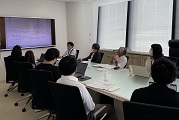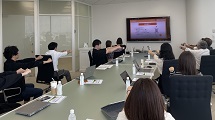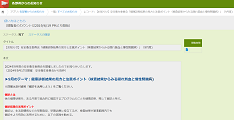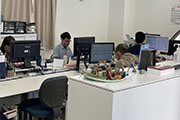Helpful Info
Sustainability
Society
Below are some examples of our group’s efforts for society.
(Updated: January 14, 2025)
- 1. Integrity to customers
- 2. Care for employees
- 3. Supplier and procurement
- 4. Considerations for local/global community
- 5. Related data (status of employees)
1. Integrity to customers
Greenhouse gas (GHG) emissions (Scope1,2,3)
Initiatives to improve quality and safety
PS business:
- Established an inquiry form on website to respond as a comprehensive contact point for customers
- Conducted customer-satisfaction surveys when pachinko/pachislot machine (hereinafter, “PS”) are delivered
- Operation of labeling and advertising in line with the guidelines of PS industry
- Acquired ISO9001:2015 certification, a global standard for quality management (FIELDS CORPORATION)
Initiatives considering diverse consumers
PS business:
- Adoption of universal design handle (“smart handle”) easy to use for both right-hand and left-hand use (some titles)
- Sales of titles with a function that can adjust volume and light by players themselves (some titles)
- Established an inquiry form on website to respond as a comprehensive contact point for customers
Initiatives to stablize supply products and services to customers
Group-wide:
- Drafting a BCP (Business Continuity Plan)
- Implementation of emergency drills at each site
PS business:
- Holding the quality meeting (management review) once a year to build a stable supply system for services that meet ISO9001:2015 certification standards
- Diversification of raw materials suppliers
- In the event of a disaster, promptly confirm the status of customers in the relevant region as well as our own bases, and provide necessary supplies in cooperation with bases in other regions to provide support to customers and neighboring communities
2. Care for employees
Policy on industrial safety and health
We have formulated our Safety and Health Management Rules with the aim of establishing and forming a comfortable working environment. We take the following necessary measures to prevent occupational accidents and to create a comfortable working environment.
- Investigation of risks and hazards, etc. and measures to be taken based on the results
- Preparation, implementation, evaluation and improvement of health and safety plans
- Implementation of medical checkups and interviews with employees subject to face-to-face guidance considering of working hours, etc.
- Measures to maintain and promote mental health
[Systems]
We have general safety and health managers, safety managers, health managers, health and safety promoters, industrial physicians, safety and health committees or health committees, depending on the type and number of employees at each business site, and perform duties required in accordance with laws and regulations.
In addition to a permanent health consultation service for implementing mental care by specialist counselors, we have established a network with external resources, including industrial physicians, specialist physicians, counselors, lawyers, and company workers, and have established a system for responding to a wide range of issues.
[Specific initiatives]
The Safety and Health Committee holds regular discussions on industrial health and safety once or more every month by committee members, who are composed of the company, several employees, and industrial physicians. The content of these discussions is reported to employees on the company portal (intranet).
We are also working with industrial physicians and specialty clinics to maintain and promote the mental and physical health of our employees.



Initiatives (example)
| Item Content | Content |
|---|---|
| Implementation of workplace stress test | The Company has formulated the “Regulations Governing the Implementation of workplace stress test” to appropriately implement primary prevention of mental health problems. Regular stress tests are conducted for all employees (regular employees, contract employees, part-time employees, and temporary workers) at least once every year or less. In response to the results of the assessment, interviews with industrial physicians are held as requested. |
| Efforts to reduce overtime | ・Hearings (physical condition and schedule of overtime in the month) shall be held during the month for employees who work more than 30 hours of overtime in the month and employees who work frequently on holidays. ・Guidance to managers to report overtime in the department/encourage efforts to reduce overtime. |
| Promotion of paid holiday usage | Guide to managers to report the paid holiday usage rate in the department/ encourage to use the paid holidays |
| Prevention of harassment | Establishment of “Harassment Prevention Regulations” to enlighten employees on the company portal (intranet), and establishment of a toll-free consultation service |
| Mental health measures | Implementation of interviews with industrial physicians and Group Human Resources and General Affairs Section |
| Efforts for safe driving | ・Check unsafe driving information in reports and video by a notice from a dash cam, and alert to drivers and report to their supervisors |
Initiatives to meet employee needs for diverse working styles
In light of recent changes in the working environment, we have established regulations on work from home, an internal system to make it easier to take childcare leave, and a system for nursing care leave. In these ways, we have established a system that enables employees with diverse backgrounds to work in accordance with their respective work styles, so that all employees can play active roles.
Initiatives (example)
| Item Content | Content |
|---|---|
| Maternity leave | Can acquire in the period of six weeks before birth (single birth) or 14 weeks (multiple birth) to eight weeks after birth. |
| Postpartum childcare leave for male employees | Male employees can acquire four weeks’ worth within the expected day of childbirth to eight weeks (can take in up to two separate periods if desired). |
| Childcare Leave | Can acquire until the child reaches one year of age (can take in up to two separate periods if desired) *In the event that the nursery school is unable, the period may be extended to two years of age by prior notification. |
| Shortened working hours | For employees living with or raising children less than the beginning of the fourth grade of elementary school or family members in need of nursing care, their fixed working hours may be reduced to a maximum of 6 hours per day in 30-minute increments, excluding breaks. |
| Family Care Leave | Employees with family members in need of nursing care can take leave to care for them. Up to five days per year for one subject family member and up to 10 days for two or more family members. |
| Family Care Leave (long) | Employees may take family care leave up to three times within a total of 93 days in principle. |
| Family care work system | Employees who care for a family member in need of nursing care may apply the shortened working hours or the acceleration/deferment system for starting and finishing times. |
| Restrictions on Employment of Maternal, Child-rearing, and Caregivers | ・The Company will not order female employees who are pregnant or who have not passed one year after childbirth to work overtime, on days off, or late at night upon request. (Provided, however, that this shall not apply to female employees in managerial/supervisory positions except for late-night work.) ・When requested by certain male and female employees who need to take care of children or other |
| Teleworking system | Employees who are ordered to work from home or have obtained permission shall work at the employees’ home or at a place equivalent to the employees’ home using information equipment leased by the Company. |
| Flex-time system | Core time shall be set in accordance with the provisions of the labor-management agreement stipulated separately, and standard working hours of eight hours shall be worked while working during the core time (excluding one hour of rest). |
| Working hour interval system | If employees worked for overnight installments or similar work, they are generally expected to start their work in the afternoon of the following day. |
| Internal recruitment system | Divisions seeking human resources recruit in-house and select employees after interviews, etc. from among those who apply |
| Stock option system | Provide stock options to enable qualified leaders of the company's new growth stage to pursue its business activities with a strong awareness of contributing to shareholder returns based on a common awareness with shareholders |
| Long Service award System | We give gifts (Gift certificates) to employees who have contributed to the company for many years and their families. (For employees in their 10th, 20th, and 30th years) |
Initiatives to support the active participation of diverse human resources
-
Opened Okinawa working center in Okinawa City, Okinawa (from April 2010)
Creating a comfortable working environment for people with various disabilities


- In our group company Total Workout premium management Inc., we are putting into practice the development of female workers who could become candidates for the next section manager by creating an environment in which female workers can positively take on challenges in leadership positions.
Evaluation system
We fairly evaluate employees' work performance and work attitudes over a certain period, and ability to perform their duties from a medium-to-long-term perspective. Based on this evaluation, we strive to optimize salaries, bonuses, assignments, promotions and demotions, educational training, promote fair and rational operation of human resources management, and encourage employees to work. We have also established Regulations for Personnel Evaluation with the aim of developing human resources and improving management efficiency.
For the full fiscal year, we conduct performance evaluations for each employee for work performance, job performance, work attitudes, and other items that we deem necessary. In order to ensure fairness, in principle, the following procedures are implemented: 1 self-evaluation, 2 primary evaluation (supervisor), and 3 secondary evaluation (supervisor of the primary evaluation).
Tsuburaya Productions Co., Ltd., one of our group companies, has been developing a new personnel system. As one of its measures, since fiscal 2024, we have conducted a “360-degree Survey and Feedback (Multi-faceted Evaluation)” for all line managers.
This measure refers to the provision of feedback on the daily behavior" of those who are being evaluated by about five to seven employees working together. Through these measures, each individual can become aware of his or her own issues and provide an opportunity to review his or her day-to-day behavior. The goal is to instill the day-to-day behavior required by the company in the organization and to deepen his or her understanding.
Education and training system
For new recruits, we provide about two months' training after they have joined the company and about one to two days' training six months after they have joined the company. These courses are designed to provide a broad range of curriculums, including business etiquette indispensable for working adults, business fundamentals, and understanding of the company. In addition, training is held on an irregular basis for all employees, including job position and rank-specific training and job-specific training.
3. Supplier and procurement
Outsourcing management regulations
We have established the Regulations for Management of Outsourcing. The purpose of this provision is to ensure the appropriateness of outsourcing operations, and it stipulates the management standards and management procedures for outsourcing operations.
Prior to the selection of subcontractors, the regulations require to investigate the necessary matters concerning the counterparties stipulated in the regulations including the status of implementation of safety measures, the intellectual property rights processing capacity, geographical conditions, the system for ensuring information security, and the compliance system. When deciding on subcontractors, the Company must compare and examine multiple potential subcontractors by means of mutual estimates and other factors, and then decide on subcontractors that have clear prospects and are in line with its objectives that it is possible to maintain quality, prices, delivery schedules, and other factors.
In addition, the departments using subcontractors are required to clarify the physical and human factors of the subcontractor's work environment in order to ensure the suitability of the subcontracting operations and outsourced products. The departments using subcontractors are also required to clarify from the viewpoint of safety and health management as necessary, and to examine the necessary constraints on the work environment, as well as to implement proposals for improvement of the work environment.
At the time of overseas outsourcing, appropriate measures are taken after fully considering the risks stipulated in the regulations (information security, infringement of intellectual property rights, risks based on differences in language, culture, and business practices, etc.).
4. Consideration for Local/Global Communities
Efforts to ensure the effectiveness of social contribution activities
- In the ULTRAMAN FOUNDATION activities to support children’s present and future, the plan was formulated at the beginning of the fiscal year based on the amount of donations from the previous fiscal year, and activities were implemented. For the most up-to-date activities and detailed information, please refer to ULTRAMAN FOUNDATION Official Website.
 ©TSUBURAYA PROD.
©TSUBURAYA PROD.
-
Implementation of voluntary cleanup activities around the head office building by employees working at the head office
Planning and operation of the number of participants and the target amount of garbage collected in the fiscal year. All employees working at the head office are contacted by e-mail in advance every month, and the activities are conducted by the members who volunteer.
![[グループCSR]能登半島地震被災地を訪問いたしました。](/ir/j/csr/social/img/4_02.jpg)
![[グループCSR]能登半島地震被災地を訪問いたしました。](/ir/j/csr/social/img/4_03.jpg)
Initiatives to help resolve issues through the provision of products and services
PS business:
- Sales of eco-friendly merchandise and antivirus merchandise to reduce electricity costs to customers
-
Contributing to the dissemination of EV vehicle recharging infrastructures, which is a challenge for promoting the widespread use of clean-energy vehicles
Cooperate with EV charging facility operators to propose installation at Pachinko hall nationwide
Content and digital business:
- KAIJU STEP SDGs Daisakusen SDGs awareness activities through the planning and production of children’s short anime, picture books, and events. For the most up-to-date activities and detailed information, please refer to the “KAIJU STEP SDGs Daisakusen Official Website.”
![[グループCSR]能登半島地震被災地を訪問いたしました。](/ir/j/csr/social/img/4_04.png)
![[グループCSR]能登半島地震被災地を訪問いたしました。](/ir/j/csr/social/img/4_05.png) © 円谷プロ ©かいじゅうステップ ワンダバダ製作委員会
© 円谷プロ ©かいじゅうステップ ワンダバダ製作委員会
-
KSIN, an avatar remote customer service
Contributing to diversification of work styles by developing 3DCG avatar remote customer service. For the most up-to-date activities and detailed information, please refer to the “Avatar Remote Customer KSIN-Unicast Robotics Official Website”.
![[グループCSR]能登半島地震被災地を訪問いたしました。](/ir/j/csr/social/img/4_06.png)
![[グループCSR]能登半島地震被災地を訪問いたしました。](/ir/j/csr/social/img/4_07.png)
5. Related data (status of employees)
| Major items | Sub-items | FY2021 | FY2022 | FY2023 |
|---|---|---|---|---|
| Employees at year-end [] The figures include the annual average number of temporary employees (including part-timers, temporary workers, non-regular workers and contract workers but excluding dispatched workers). |
Consolidated | 1,193[357] | 1,259[351] | 1,423[453] |
| Ratio of temporary employees*1 | 23.0% | 21.8% | 24.1% | |
| Age status*2 | Average age | 40.3 years old | 40.9 years old | 41.2 years old |
| Status of service*2 | Years of service | 13.7 years | 13.2 years | 12.9 years |
| Turnover*2 | Number of employees who left the company | 38 people | 29 people | 46 people |
| Number of new hires*2 | Hiring of new graduates | 7 | 3 | 23 |
| Number of mid-career recruits | 6 | 25 | 43 | |
| Retention of new graduates hired three years ago*2 | Number of employees after three years/Number of new graduates hired three years ago () The figures show the ratio of new graduates hired three years ago to the number of new graduates hired three years ago. |
As of Apr. 2022, 6/10 people (60.0%) |
As of Apr. 2023, 12/13 people (92.3%) |
As of Apr. 2024, 3/7 people (42.9%) |
| Overtime work | Monthly average overtime hours | 13.0 | 11.8 | 13.3 |
| Occupational health and safety-related data*2 *3 () The figure shows the ratio of employees on leave at the end of the period to the number of employees at the end of the period. |
Frequency rate of work-related injuries:% *4 | 0.00 | 0.00 | 0.00 |
| Number of employees on leave due to mental health issues, etc.: People (%) | 3(0.6%) | 1(0.2%) | 3(0.4%) | |
| Number of employees using the childcare and nursing care leave systems*2 () Figures are the percentage of those who acquired the certification to those who could acquire the certification. |
Employees taking maternity leave | 2 | 5 | 5 |
| Employees taking childcare leave: People (%) | 2(8.0%) | 6(26.0%) | 8(33.3%) | |
| Of which, women | 2(100%) | 6(26.0%) | 3(100%) | |
| Of which, men | 0(0%) | 3(15.0%) | 5(23.8%) | |
| Childcare leave reinstatement rate | 100% | 100% | 100% | |
| Employees taking nursing care leave | Unknown | Unknown | Unknown | |
| Understanding the days of paid holidays taken and the percentage of leave taken*2 | Number of paid holidays | 18.5 | 18.4 | 17.7 |
| Number of days of acquisition | 11.8 | 12.8 | 11.1 | |
| Usage rate | 64.0% | 69.9% | 62.3% | |
| Ratio of women*2 | Ratio of female employees | 13.1% | 12.7% | 12.3% |
| Percentage of female managerial staff | 1.9% | 1.3% | 2.0% | |
| Percentage of Women's Director | 14.3% 1/7 people |
11.1% 2/18 people |
11.8% 2/17 people |
|
| Ratio of Female Executive Officers | 0% 0/7 people |
0% |
0% 0/12 people |
|
| Difference in wages between male and female workers*5 | Total labor | ― | 61.6% | 60.2% |
| Regular workers | ― | 66.7% (*6) | 65.3% (*6) | |
| Part-time and fixed-term workers | ― | 63.1% | 46.1% | |
| Percentage of employees with disabilities, number*2 | Number of personnel with disabilities | 8 | 8 | 10 |
| Employment rate | 2.30% | 1.95% | 2.16% | |
| Average education and training per employee*2 | Expenses *7 | 28,073 yen | 31,988 yen | 44,113 yen |
*1. Average annual number of temporary employees/ (Number of employees at the end of the consolidated fiscal year + Average annual number of temporary employees)
*2. Scope: TSUBURAYA FIELDS HOLDINGS INC., FIELDS CORPORATION
*3. Employees on leave of absence of at least one month. If the same employee takes a leave of absence more than once during the fiscal year, one employee shall be eligible.
*4. Number of lost-time injuries/Total working hours × 1 million hours
*5. Scope: FIELDS CORPORATION
*6. With respect to the “Regular Employed Workers” under the “Difference in wages between men and women Workers,” the women’s Labor Standards are prohibited under Article 2, Paragraph 1 of regulation to allow women to work in jobs that continuously handle goods weighing 30 kilograms or more. Therefore, it is difficult to assign women to sales positions where the handling of such heavy goods (pachinko/pachislot machine) is essential. This is because there are no business allowance and incentive payments to be paid to such sales positions.
*7. Expenses related to education and training/ (Number of employees at the end of the fiscal year + Annual average number of temporary employees)

